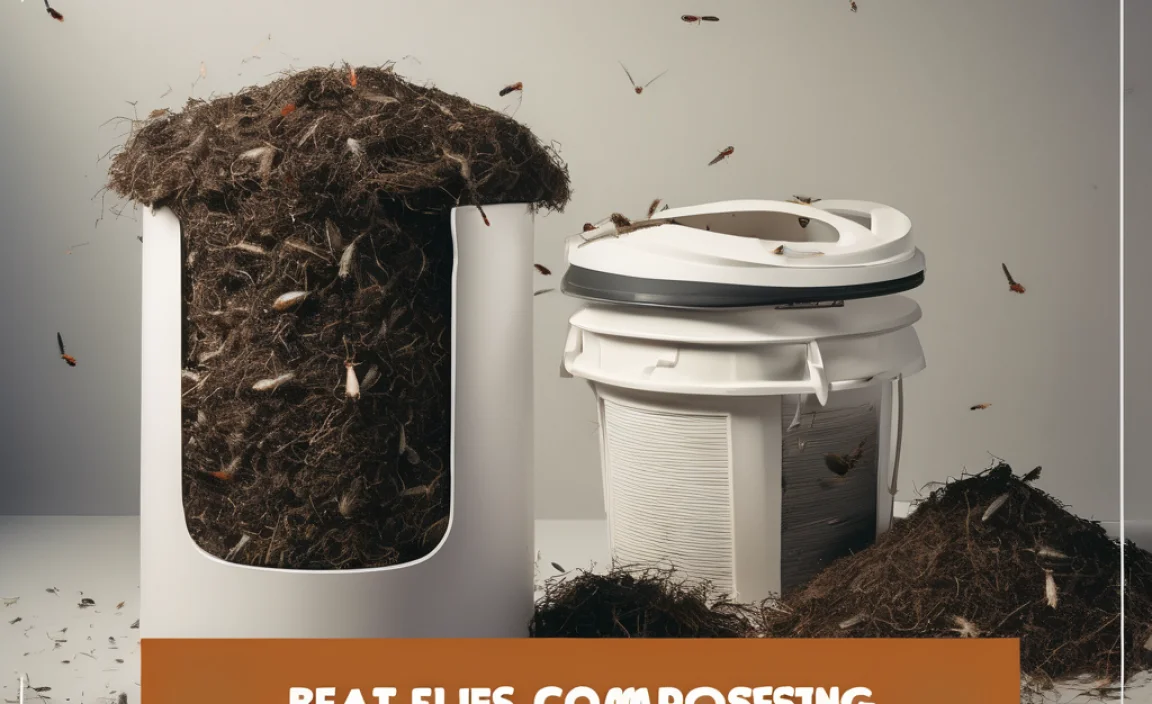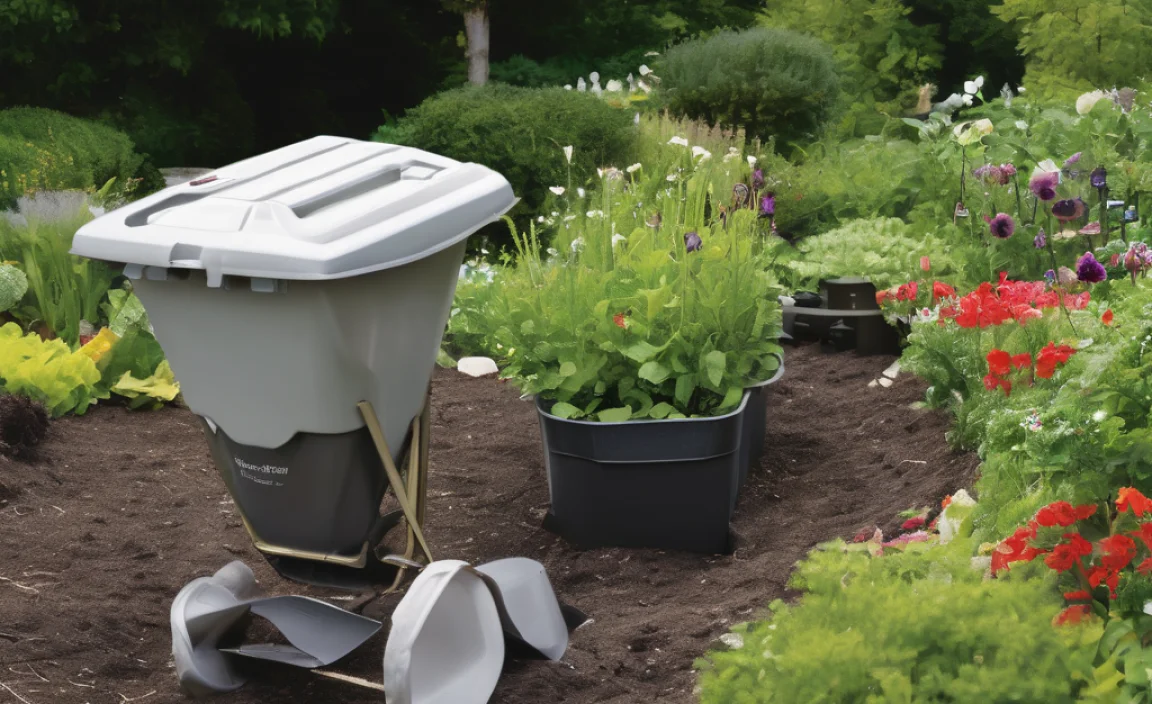Dreaming of a greener lifestyle but feel stuck in a small apartment? Composting might sound like a big undertaking, but it doesn’t have to be! If you thought composting was only for folks with sprawling backyards, think again. We’re here to show you that you can absolutely compost even in the coziest of living spaces. It’s totally doable, and we’ll guide you through it step-by-step.
Composting For Small Apartments: Genius, Essential Tips
Hey there! Troy D Harn here from TopChooser. I know that when we talk about home improvement, gardening, or anything eco-friendly for our living spaces, the idea of composting can seem a bit… overwhelming, especially if you’re rocking apartment life. You might be picturing giant bins and a whole lot of mess, right? Well, let me tell you, it’s much simpler than you think! We’re going to break down how you can easily compost right there in your apartment, turning kitchen scraps into valuable garden gold without any fuss.
We’ll cover the best methods for small spaces, what you’ll need, and how to keep things clean and odor-free. Get ready to embrace a more sustainable way of living!
Why Compost in Your Apartment?
You might be wondering, “Why bother composting if I don’t have a garden?” Great question! Composting, even on a small scale, offers some fantastic benefits:
- Reduces Waste: Food scraps make up a significant portion of household trash. Composting diverts this from landfills, which is great for the environment (think less methane gas!).
- Creates Nutrient-Rich Soil: The end product, compost, is like superfood for plants. It can enrich your houseplants, a balcony garden, or even be donated to a local community garden.
- Saves Money: You’ll buy less potting soil and fertilizers for your plants.
- Connects You to Nature: It’s a simple yet profound way to engage with natural cycles and reduce your environmental footprint.
Getting Started: Choosing Your Apartment Composting Method
When you’re composting in tight quarters, the key is picking a method that’s compact, tidy, and doesn’t smell up your place. Here are the top contenders for apartment dwellers:
1. The Bokashi Bin: The Fermenting Friend
Bokashi isn’t traditional composting; it’s a fermentation process. Think of it as pickling your food scraps! It uses an anaerobic (oxygen-free) method with a special inoculated bran. It’s super effective and great for apartment living because it:
- Doesn’t smell: The fermentation process actually preserves the waste and prevents foul odors. It might have a slightly vinegary or yeasty smell, which is totally normal.
- Handles more: It can break down more types of food waste than traditional composting, including meat, dairy, and oils – things you usually avoid in other compost systems.
- Is compact: Bokashi bins are typically small, sealable buckets that fit easily under your sink.
- Produces a liquid that can be diluted and used as a potent plant fertilizer, often called “Bokashi tea.”
How it works: You layer your food scraps with the Bokashi bran in the airtight bin. Once full, you let it sit for about two weeks to ferment. After fermentation, the material still needs to be buried or added to a larger compost system to fully decompose. For apartment dwellers, this means you might need to add the fermented material to a community garden, a friend’s compost pile, or a local drop-off point. Some people also bury it in large outdoor pots.
2. The Worm Bin (Vermicomposting): Little Workers, Big Results
Vermicomposting uses special composting worms, like Red Wigglers, to eat your food scraps and turn them into rich compost, also known as worm castings. This is a fantastic, earth-friendly method for apartments because:
- It’s efficient: Worms are speedy eaters and produce high-quality compost.
- It’s clean: When managed correctly, it has minimal odor and is quite tidy.
- It’s relatively small: Worm bins can be purchased or DIY’d to fit in a corner or under a designated spot.
What you need for vermicomposting:
- A worm bin: You can buy a specially designed bin or make one yourself from a plastic tote. Look for bins that have drainage and ventilation. A common DIY setup involves two totes, one stacked inside the other with holes drilled for drainage and air. Visit resources like EarthEasy for detailed DIY guides.
- Composting worms: Red Wigglers (Eisenia fetida) or European Nightcrawlers (Eisenia hortensis) are your best bet, not regular earthworms from your garden. You can usually order these online.
- Bedding: This is what the worms live in and munch on. Shredded newspaper, cardboard, coconut coir, or aged leaves work well. It needs to be moist but not soaking wet.
- Food scraps: Most fruit and vegetable scraps, coffee grounds, tea bags, and crushed eggshells are great. Avoid meat, dairy, oily foods, citrus in large quantities, and spicy foods.
How it works: You’ll set up the bin with bedding, introduce the worms, and then start adding food scraps in moderation. Bury the scraps under the bedding. The worms will eat the scraps and the bedding, leaving behind nutrient-rich worm castings. You’ll regularly harvest these castings. Remember to keep the bin out of direct sunlight and extreme temperatures.
3. Electric Composter: The High-Tech Solution
If you want the fastest, almost foolproof composting method for your apartment, an electric composter might be for you. These countertop appliances use heat, aeration, and sometimes grinding to break down food scraps into a dry, soil-like amendment in a matter of hours.
- Speed: These truly are the fastest option, turning waste into usable material in 4-8 hours.
- Odor Control: Most models have effective carbon filters to eliminate smells almost entirely.
- Simplicity: Just add scraps, close the lid, and press start.
- Compact: They are designed to sit on your countertop, much like a bread maker.
Downsides: They are the most expensive option and use electricity. The end product is more of a dried amendment than fully mature compost, so it still needs to break down further in soil before planting, or be used very sparingly as a top dressing.
4. Community Composting or Drop-Off Programs
Don’t have the space or inclination for an indoor system? Look for local solutions! Many cities and towns have community gardens or composting facilities that accept food scraps from residents. Some farmers’ markets also have drop-off points.
- Minimal effort: You just collect your scraps and take them to a designated spot.
- No mess, no smell at home: You don’t have to manage it within your apartment.
- Supports local initiatives: You’re contributing to a larger, community-based composting effort.
How to find them: Search online for “[Your City] community composting” or “[Your City] food scrap drop-off.” Websites like the EPA’s composting page can offer general information and links to local resources.
What You CAN and CAN’T Compost (Generally)
While the Bokashi method handles more, most apartment composting systems (especially vermicomposting) have specific “dos and don’ts.” Here’s a general guide:
| Compostable (Greens & Browns) | Not Recommended (or Bokashi Only) |
|---|---|
| Fruit scraps (peels, cores, etc.) | Meat, bones, and fish scraps (Bokashi can handle these) |
| Vegetable scraps (stems, leaves, peels) | Dairy products (cheese, milk, yogurt – Bokashi can handle these) |
| Coffee grounds and filters | Oily foods and grease (Bokashi can handle these) |
| Tea bags (check for plastic tags) | Diseased plants or weeds that have gone to seed |
| Crushed eggshells | Pet waste (dog/cat feces) |
| Stale bread, pasta, rice (in moderation, especially for worms) | Chemically treated wood or yard waste |
| Paper products (shredded newspaper, paper towel rolls) – these are “browns” | Coal ash or charcoal briquettes |
| Cardboard (small pieces, torn up) – these are “browns” | Glossy paper or magazines |
| Houseplant trimmings | Anything not specified as compostable (e.g., synthetic materials) |
“Greens” vs. “Browns”: For traditional (and some worm) composting, it’s all about balance. Greens are nitrogen-rich (food scraps, grass clippings) and Browns are carbon-rich (paper, cardboard, dry leaves). You need a good mix. Apartment systems like Bokashi or electric composters are more forgiving of ratios.
Setting Up Your Chosen System: A Step-by-Step Approach
Let’s get down to the practical steps for the most popular apartment methods:
Setting Up a Worm Bin (Vermicomposting)
- Prepare your bin: If DIYing, drill drainage holes in the bottom of one tote and ventilation holes in the lid and sides of that same tote. Stack this tote inside a second, solid tote (to catch liquid).
- Add bedding: Moisten your shredded newspaper, coco coir, or other bedding material until it feels like a wrung-out sponge. Fluff it up and fill your bin about 2/3 full.
- Introduce the worms: Gently place your purchased worms on top of the bedding. Leave the lid off for an hour or two; they’ll burrow down.
- Add initial food: Bury a small amount of food scraps (like melon rinds or coffee grounds) under the bedding in one corner.
- Close it up: Secure the lid. Place the bin in a cool, dark place (like under the sink or in a closet).
- Feed regularly: Start by feeding them small amounts every few days, burying the food under new bedding. As they multiply and eat more, you can increase the amount. Remember the “dos and don’ts” list!
- Harvest castings: After a few months, you’ll see dark, crumbly “worm castings.” You can harvest these by:
- Migration method: Add fresh bedding and food to one side of the bin. The worms will migrate to the new food, leaving the old side clear for harvesting.
- Light method: Dump the bin’s contents onto a tarp or newspaper under bright light. Worms hate light and will burrow down. Scrape off the top layer of castings, let them burrow again, and repeat until you’re left with mostly worms and a little bedding. Return the worms to the bin.
- Manage leachate: The liquid that collects in the bottom tote (leachate) can be a super-rich fertilizer. Dilute it with water (about 1:10 ratio) and use it for your plants.
Setting Up a Bokashi Bin
- Add food scraps: Place your acceptable food scraps into the Bokashi bin. Chop larger items into smaller pieces to help them ferment faster.
- Sprinkle with Bokashi bran: Sprinkle a generous tablespoon or two of Bokashi bran over the food scraps.
- Compact and seal: Press down the food and bran mixture to remove air pockets. Seal the lid tightly.
- Repeat: Continue adding scraps, bran, and compacting until the bin is full.
- Ferment: Once full, seal the bin and let it sit in a warm-ish spot for at least two weeks. You might need to drain off the “Bokashi tea” (fertilizer liquid) every few days by opening the spigot at the bottom.
- Post-fermentation: After two weeks, the material will be fermented. You’ll need to bury this in soil (a large planter, a community garden) for it to break down fully into compost, or add it to another compost system.
Tips for Success: Keeping it Clean and Odor-Free
The biggest worry for apartment composting is odor. Thankfully, with the right method and a few smart habits, you can keep your home smelling fresh:
- Chop it up: Smaller pieces of food scraps break down faster and can help prevent odors.
- Balance is key (especially for worms): If you notice a strong ammonia smell in a worm bin, you likely have too many “greens” (food scraps) and not enough “browns” (bedding like shredded paper). Add more dry browns.
- Don’t overfeed: Especially with worms, only add as much food as they can eat in a few days. If food starts to accumulate and smell rotten, you’re feeding too much.
- Bury your scraps: In worm bins, always bury food scraps under the bedding. This keeps flies away and contains any potential odors.
- Drain that liquid: For Bokashi bins, drain the “tea” regularly to prevent it from becoming stagnant and smelly. Dilute it properly before using it on plants – undiluted, it can burn them.
- Use a countertop caddy: For collecting scraps before taking them to your main bin, a small countertop caddy with a lid can keep things neat and contained. Empty it daily or every other day.
- Activated Carbon Filters: Electric composters and some enclosed worm bins use these. Replace them as recommended by the manufacturer to ensure optimal odor control.
What to Do With Your Finished Compost
Once you’ve successfully made compost (or worm castings!), you’ll have a valuable resource. Here are some ideas for your apartment:
- Houseplants: Mix a little compost into the soil of your indoor plants to give them a nutrient boost. About 10-20% compost mixed with potting soil is a good starting point.
- Balcony or Patio Garden: If you have the space for pots, compost is fantastic for growing herbs, vegetables, or flowers.
- Repotting: Use it when repotting plants to enrich their new soil.
- Donate: Offer your finished compost to friends, family, or a local community garden. You’ll be surprised how much people appreciate it!
- Top Dressing: A thin layer of compost on top of plant soil can slowly release nutrients and help retain moisture.
Troubleshooting Common Apartment Composting Issues
Even with the best advice, you might run into a snag. Here are some common problems and how to fix them:
Issue: Fruit Flies or Pests
Cause: Exposed food scraps, inadequate bin sealing.
Solution: Ensure food is buried under bedding (worm bin). Check that Bokashi bin lid is sealed tight. Use a countertop caddy with a tight lid. For worm bins, you can try adding a layer of dry bedding on top or even a small amount of diatomaceous earth around the bin’s base.
Issue: Smelly Bin
Cause: Too much food, not enough air (anaerobic decomposition), wrong materials added.
Solution: For worm bins, add more “browns” (shredded paper/cardboard) and stop feeding for a few days. Fluff the bedding to increase aeration. For Bokashi, ensure you’re draining the liquid. For electric composters, check the filter and ensure you’re not overloading it with wet items.
Issue: Worms Trying to Escape
Cause: Bin is too wet, too dry, too acidic (too many citrus scraps), or has gone anaerobic.
Solution: Adjust moisture levels. Add more bedding if too wet, or a little water if too dry. Remove excessive citrus. If it smells fetid, it’s likely anaerobic – add dry bedding and aerate.
Issue: Not Breaking Down Quickly Enough
Cause: Bin is too cold, not enough moisture, too many “browns” (for worms), or simply takes time.
Solution

I am passionate about home engineering. I specialize in designing, installing, and maintaining heating, ventilation, and air conditioning systems. My goal is to help people stay comfortable in their homes all year long.



